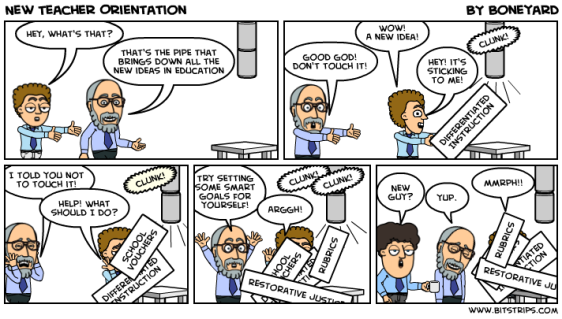On the theme of popular ideas that I feel a need to critique….
Bloom’s taxonomy has been around for a long time as an aid to teachers, presented as a hierarchy of sophistication of thinking. I was first introduced to it when I started teaching in the 1980s. The college where I currently teach asks all of their instructors to keep it in mind when developing and teaching their courses.
I have two central problems with Bloom’s taxonomy, both of which I will discuss. Then I will mention how it can be used positively.
First of all, when I have used Bloom’s list, or the new revised list, to analyze a lesson and to think about which categories are being tapped into, I find it hard to pigeonhole activities or questions. My teacher education students and I often find that we can put the same questions into multiple categories depending on how we interpret them. In other words, real ideas and lessons do not seem to fit neatly into these categories, and getting agreement on categories is not intuitive, making them less useful. For instance the top of the six categories is: Creating, putting information together in innovative ways. But “Applying” (third level from bottom) on one chart I am reading is listed as using the knowledge gained (level 2) in new ways. What is the difference between applying knowledge in a new way and being creative or innovative?
A bigger problem I have with Bloom’s taxonomy is that they are presented as a hierarchy, and Bloom meant them that way. In this hierarchy the first stage is knowledge or remembering. In other words, rote learning comes first. The next level, understanding, is that then we learn the meaning of what we memorized. Next we learn to apply the knowledge. After that we can analyze it—break it into parts. Then we can judge it. And finally we can use it creatively. For instance, I was told by someone instructing college professors that they would not get to the highest category with undergraduates, but should reserve that for graduate students!
If Bloom’s taxonomy were used just as a taxonomy—in other words a description of different types of thinking, I can see them as interesting and possibly useful. But generally they are used in the former way as developmental steps to be gone through, as Bloom designed them to be used.
My experience in elementary school bears this out. The “low achievers” and “remedial students” we are told first need to get the basics, and they are given tasks that focus on rote memorization, factual recall and following instructions. The “advanced” or “gifted” students are given assignments that allow them to be creative and analytical. They are asked to evaluate the characters in the story, to do the creative extension activities, and in math they get to do the extra “thinking” problems in the textbook.
This hierarchical idea of thinking ignores what Piaget demonstrated so long ago. Even babies are engaged in all levels of this taxonomy, and the different forms work together synergistically not separately. Learning by rote is the most inefficient way to learn. We are more likely to remember something when it has meaning attached to it. Then even more likely when we apply the knowledge, which is why hands-on and authentic activities are so often recommended. I would want most of the activities that students are engaged in at school to have them using all of these levels of thinking as they carry them out.
Any kindergarten teacher will tell you her kindergartners are creative. In fact there is some research that shows that we actually become less creative and innovative as we progress through school, less able to see the world in new and novel ways, not more so. I hope we do not wait until our students are in graduate school before we let and encourage them be innovative again, the way they naturally were as children.
It is possible to use Bloom’s taxonomy in a positive way. For instance, we create a teaching unit (level 6). We can analyze our unit to see it if includes all the levels of Bloom’s taxonomy (level 4). We apply the unit as we carry out our lessons (level 3), for which we must have understanding and knowledge of our content and pedagogy (levels 1 & 2). As we go along and at the end we evaluate the unit and how it went (level 5).
For a full look at this whole idea of teaching children to think, one should read Franks Smith’s book, To Think.

Pingback: Bloom’s Taxonomy | Deborah Meier on Education
I love Frank Smith
Actually the value of Bloom’s Taxonomy is that it provides some structure for teachers (at all levels and with all students) to ask questions, assign tasks, inspire reading, and encourage learning activities which stimulate critical thinking. Common Core goes well beyond Blooms because it emphasizes Webb’s Depth of Knowledge Levels. Check out Hess’ Cognitive Rigor matrix. All of it is geared towards more rigorous teaching and learning. Not so much a fad but the next evolutionary step in improving pedagogy. Personally, as a long time K-8 school leader (35 years) at a high poverty-HIGH achieving school in Southern California, I have found these “taxonomies” to be extremely valuable.
Pingback: Educational Readings August 9th | The Treehorn Express